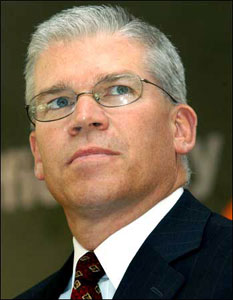
In this interview in Business Week of TI CEO Richard Templeton talks about future business opportunities for his company. About 40% of TI's sales come from analog chips rather than the fancy new 45 nanometer DSPs (digital signal processors), microprocessors and other digital circuits.
Templeton talks about innovation, Apple and the personal computer industry (as an example of an industry with almost zero innovation).
First, I think it's great when we have customers in a market where people invest in research and development, who innovate and grow. And I put that up there in contrast with the PC industry. PC companies invest what amount of their revenue in R&D?The fact is, if it's a point or a point and a half, that's very little. And so when people sit back and ask why there isn't anything new, it ought to be an obvious answer. The PC companies aren't investing. When I say I think it's wonderful that there are companies like Apple (AAPL) investing in R&D, improving the user interface, new features, [and] companies like Nokia, Ericsson, Motorola all working on R&D, that's all good stuff because when those people are doing that, it's going to lead to new ideas and growth. And the last time I checked, chip companies can't grow if the people they sell to are not growing accordingly.
While established medical device vendors spend a lot more than 1% or 1.5% of revenues on R&D, the level of innovation seems to be on par with
the PC industry (more on that later). When asked what industry TI should focus on in the future, Templeton offered this:
If there is one thing we're saying right now is that analog has become an even more important opportunity than before. There's a lot of growth potential that we can still find. And it doesn't make the front page of an annual report, and it's not this big single killer application. It's just a very large, very diversified, very good opportunity. But we're beginning to see a lot of emerging and new opportunities in the same way that semiconductors have revolutionized computing and communications. Think about the medical industry. It's about 15% of the GDP in the U.S., but the impact of semiconductors in medicine is near zero.
Whoa! While health care does make up a major portion of the U.S. GDP, most of that is spent actually delivering health care.
Medical devices used in diagnosis, therapy delivery and surveillance are a fraction of the almost $2 trillion spent on health care. That aside, we're still talking about real money. The medical devices that are part of that $2 trillion is based heavily on the kinds of components made by TI. After a few examples of medical devices that use TI components, Templeton outlines their approach to health care.
I'd guess we have 8 to 10 people from different product areas that are gathered up into a medical team. Plus, I have a smaller group that I get together with a few times a year to try to understand where we're going. We've had those groups at a half-dozen medical schools and bioengineering schools. We want to get a snapshot about the tough and gnarly problems they're looking at 5 and 10 years down the road.
We're staying closely connected with a lot of the smaller customers, very innovative companies, a lot of them not public. Few even make it public because they get acquired before they get to that point.
Other than a very few places like Mayo or Partners, I don't see much innovation coming out of biomedical engineering schools - or medical schools, for that matter. Most of the new ideas are coming out of the startups. Anticipating what will be needed in 5 or 10 years is a good thing, but there are problems right now waiting to be solved. The biggest challenges revolve around the inherently mobile nature of health care delivery and include miniaturization, reducing power consumption, and wireless enablement.
One of the problems that medical device innovation is low and R&D budgets are high (at least compared to PC manufacturers) is that current product architectures are very expensive to develop and have long times to market. Anything TI could do to package I/O, display support and connectivity that would lower part counts and reduce engineering time would be significant.
Someone like TI needs the medical device industry to really take off - to increase medical device turn-over with new disruptive products. Templeton said as much in his presentation at TI's annual stock holders meeting last month:
Longer term, we see great potential for TI to help revolutionize the health care market around the world. We believe in the next decade that semiconductor innovation can dramatically improve the quality of people’s lives by making health care less expensive, less invasive, and more accessible to a greater number of people.
The reality is that most of the big players - Philip, GE Healthcare, Siemens - are content with things as they are. They don't want to do anything that will put their large installed bases in play. Disruption will come to the medical device market, and companies like TI can both hasten the day and greatly benefit from the changes - if they do the right things now.
Pictured above is TI CEO Richard Templeton.


Recent Comments